- Quick Read
- Deep Read ( 9 Min. )

Why is Christian Science in our name?
Our name is about honesty. The Monitor is owned by The Christian Science Church, and we’ve always been transparent about that.
The Church publishes the Monitor because it sees good journalism as vital to progress in the world. Since 1908, we’ve aimed “to injure no man, but to bless all mankind,” as our founder, Mary Baker Eddy, put it.
Here, you’ll find award-winning journalism not driven by commercial influences – a news organization that takes seriously its mission to uplift the world by seeking solutions and finding reasons for credible hope.
Explore values journalism About usIn Today’s Issue
- The rumors targeted Haitians. All of Springfield is paying the price.
- Today’s news briefs
- How Project 2025, designed to aid Trump, became a liability instead
- Why Putin’s nuclear saber-rattling on Ukraine sounds different now
- European governments, under pressure, raise barriers to migrants
- Kick off your fall with the Monitor’s 10 best books of September
Monitor Daily Podcast
- Follow us:
- Apple Podcasts
- Spotify
- RSS Feed
- Download
TODAY’S INTRO
A collision of hate and love
Nothing serves journalism better than being there, reporting with a sense of place, and speaking with people whose stories have yet to be told.
We have a story today from Springfield, Ohio, on the effect of recanted charges of aberrant behavior – claims that have led to the political demonization of a community. Claims that have hurt people – mostly legal residents on Temporary Protected Status and those around them.
It’s another deftly executed Monitor piece by a careful writer. It showcases not only the indiscriminate effects of hate and fear – mental terrorism, really – but also the agency of those who are responding with love.
Share this article
Link copied.

Help fund Monitor journalism for $11/ month
Already a subscriber? Login

Monitor journalism changes lives because we open that too-small box that most people think they live in. We believe news can and should expand a sense of identity and possibility beyond narrow conventional expectations.
Our work isn't possible without your support.
A deeper look
The rumors targeted Haitians. All of Springfield is paying the price.
Historians have long warned that people in the United States need to stop demonizing one another. The costs of acidic rhetoric are on display in Springfield, Ohio, where discredited rumors became a political football.

On Friday, the second graders in Lisa Pankratz’s class in Springfield, Ohio, were supposed to practice taking measurements, read a story about a chameleon desiring a color of his own, and attend gym class.
Instead, teachers at Snowhill Elementary School were rounding up students who had already arrived and turning away others. A bomb threat tied to a rumor-turned-lie about the city’s growing Haitian immigrant population had forced an evacuation.
Residents like Ms. Pankratz feel disheartened. Frustrated, even.
“Why are adults pulling children into this?” she asks. “What do the lives of children have to do with politics?”
Dozens of bomb threats have escalated safety concerns in this Midwestern city. Multiple schools and city buildings have been evacuated, and residents interviewed talk about a simmering sense of unease and daily life disrupted. In a nutshell, Springfield has come under verbal siege.
The city is a parable of the effects that coarsening political discourse has had on U.S. society. Long decried by historians as corrosive, once unleashed, politicized hatred cannot be contained within its banks. And, as Springfield shows, it hurts everyone.
At Snowhill, the chaos and fear have stymied learning, but one thing has not changed: Ms. Pankratz continues telling her students, including two Haitian children, that she loves them.
It’s a message she wants the city’s youngest members to grow up hearing.
The rumors targeted Haitians. All of Springfield is paying the price.
It was a day of scrapped lesson plans.
On Friday, the second graders in Lisa Pankratz’s class in Springfield, Ohio, were supposed to practice taking measurements, read a story about a chameleon desiring a color of his own, and attend their favorite special – gym class.
Instead, before the school day officially began, teachers at Snowhill Elementary School were rounding up students who had already arrived and turning away others whose parents were dropping them off. A bomb threat tied to a rumor-turned-lie about the city’s growing Haitian immigrant population had forced an evacuation. Ms. Pankratz addressed it delicately.
“What do you notice? ... What do you wonder?” she asked.
Her students offered their observations and questions. So as Ms. Pankratz helped the little ones board a bus bound for the high school, she shared what she could.
“Snowhill is not safe for us to be in right now,” she told them. “We need to go to a place that is safe for you. And remember: My No. 1 job is to keep you safe.”
Dozens of bomb threats have escalated physical safety concerns in this Midwestern city sandwiched between Dayton and Columbus. Multiple schools and city buildings have been evacuated both this week and last, and residents interviewed talk about a simmering sense of unease and daily life disrupted. In a nutshell, Springfield has come under verbal siege.

The city is a parable of the effects that coarsening political discourse has had on U.S. society. Long decried by historians as corrosive, once unleashed, politicized hatred cannot be contained within its banks. And, as Springfield shows, it hurts everyone.
Tensions were brewing here before a discredited rumor about the community’s Haitian immigrants eating neighborhood pets gained traction online. Then it was amplified by the GOP presidential ticket. Former President Donald Trump and his running mate, Ohio Sen. JD Vance, repeated the incendiary claim in interviews, on the debate stage, and on the campaign trail. Gov. Mike DeWine, a fellow Republican, and city officials have said the claim is not true.
Suddenly, Springfield found itself thrust into the national spotlight as the latest backdrop for heated immigration rhetoric less than two months before the election.
Governor DeWine has appeared alongside local leaders in a bid to assuage fears and announce extra security precautions: three dozen state troopers monitoring city schools, “vulnerability assessments” of critical infrastructure, tower cameras strategically placed around town, and bomb-sniffing dogs.
The threats have originated from both foreign and domestic sources, Mr. DeWine says, with many coming from overseas.
Regardless, the swatting attempts have gobbled up time and resources. Residents like Ms. Pankratz feel disheartened. Frustrated, even.
“Why are adults pulling children into this?” she asks. “What do the lives of children have to do with politics?”

The bus full of evacuated children chugged forward Friday, passing her house on a nearby street. Ms. Pankratz looked longingly at her front porch and told her students she wished they could be there, eating pancakes with each other.
The image conjures a joy and unity she hopes to see rise from the aftermath of this turbulent chapter in the city’s history.
How Haitian immigrants power Springfield’s economy
New Diaspora Live, billed as the Midwest’s most diverse studio, occupies a window-framed office inside a popular coworking space in Springfield. But on Tuesday morning, it might as well be located within Grand Central station. Visitors stream in and out of the radio station run by Haitian residents. Others congregate just outside it.
Miguelito Jerome temporarily closed his furniture store. He realized the radio station, where he serves as a radio host and executive manager, plays a pivotal role in changing the narrative.
“We understood that if we don’t address this situation, there is no place safe in America,” he says.
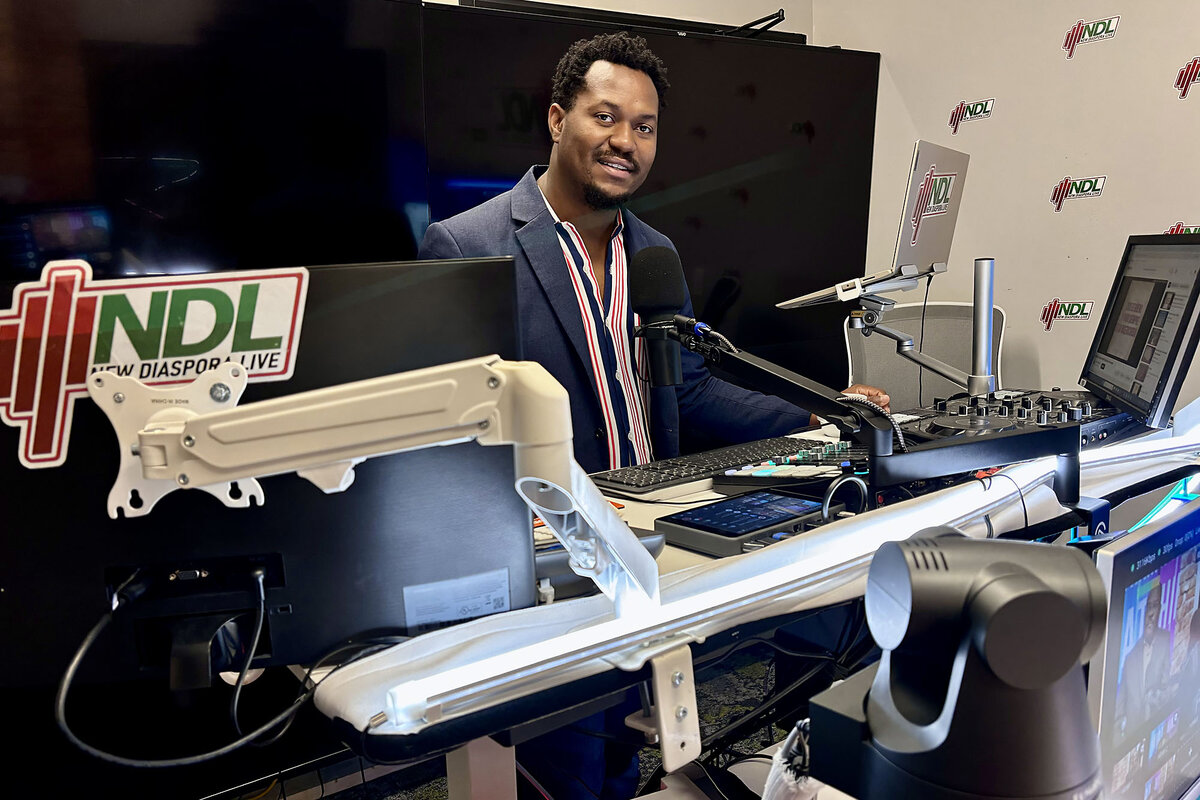
Mr. Jerome came to the United States three years ago. He never intended to stay long-term, but while here, the Caribbean nation’s then-president was assassinated. The violent act threw Haiti into civil upheaval, compounded by an earthquake, and created a humanitarian crisis. The multilingual entrepreneur settled in Springfield, lured by a friend who thought he could help the city’s growing Haitian immigrant population.
It is unclear how many Haitians live in Springfield, although the city website estimates that there are at least 12,000 immigrants overall. The U.S. Census Bureau does not track that data, making it difficult to pinpoint exact numbers. Many Haitians have a legal designation given through a federal program known as Temporary Protected Status. As the name suggests, it temporarily shields certain immigrants from deportation if civil unrest, natural disasters, or other unfavorable conditions would make returning to their home countries dangerous. For his part, Mr. Jerome estimates that about 10,000 Haitians are in the city now.
Temporary Protected Status recipients are eligible for work permits, and when the initial migration surge started, Springfield had what Haitian immigrants needed next – a job. They’re working in warehouses, manufacturing centers, and in the service industry, city officials say. Others are launching their own businesses, such as restaurants and grocery stores.

Governor DeWine has said business leaders told him the Haitian immigrants took positions they were struggling to fill postpandemic. The employment boost, in turn, has been helping power the economy of this once-vibrant manufacturing city.
“Springfield is on the move,” Mr. DeWine said at a press conference Tuesday. “I couldn’t have said that 10 years ago.”
Growing pains and canceled festivals
That’s not to say growing pains don’t exist. Residents say tensions have been bubbling over issues such as unsafe driving habits, language barriers at the grocery store, and long lines at the Bureau of Motor Vehicles. There have been concerns about rent increases and, on the flip side, worries about immigrants’ living conditions and vulnerability to exploitation. Schools, too, have felt the strain of serving hundreds of new-to-country students.
A tipping point came in August 2023 when a school bus crash involving a Haitian driver killed 11-year-old Aiden Clark. Politicians, including Mr. Trump and Mr. Vance, latched onto the tragedy for what Aiden’s father has described as “political gain.” He has pleaded with them to stop using his son’s name for that purpose.
“After the accident, that’s when everything started changing, because it created a situation of fear,” says Mr. Jerome, who ramped up information about safe driving on the radio station.
Still, the city’s Haitian community retreated a bit, he says. It scaled back this year’s plans for a Haitian Flag Day event earlier this year.
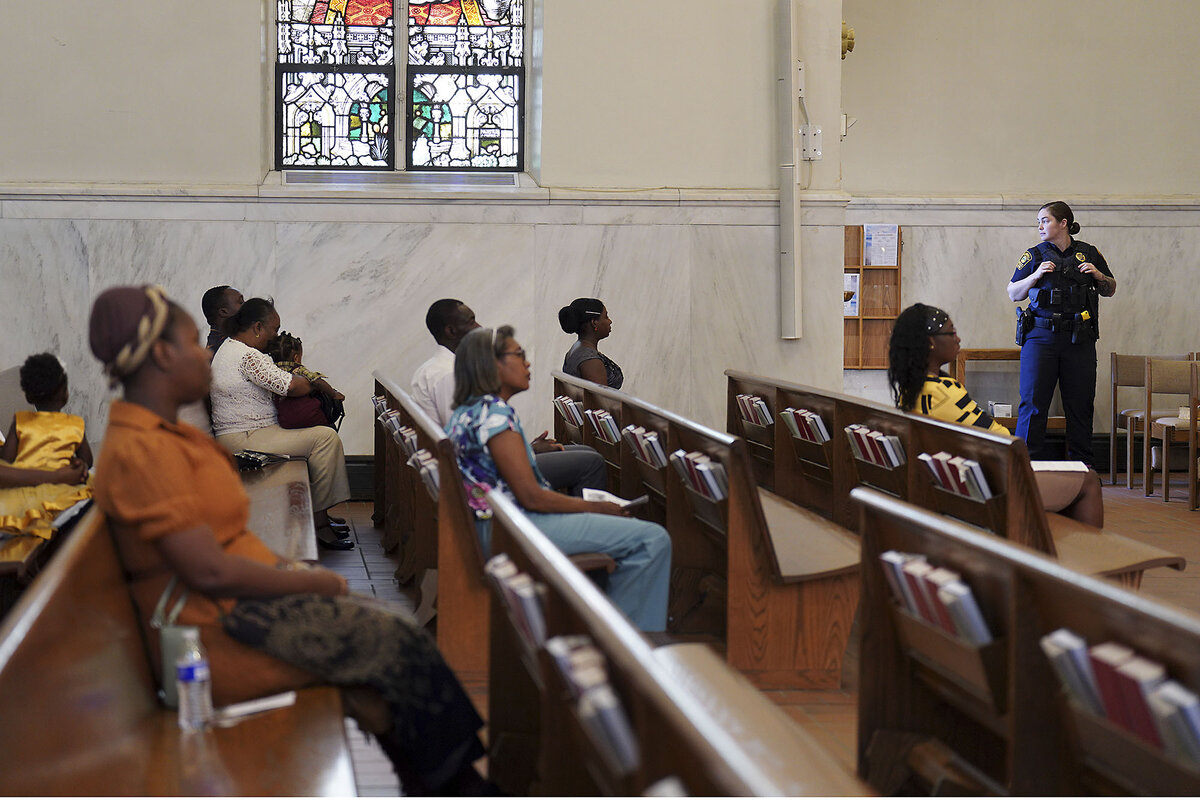
The baseless accusations about cats and dogs – since recanted by two local women – stoked those fears within the Haitian community and triggered a ripple effect across Springfield. The bomb threats have caused school attendance to plunge. One school logged 200 students absent out of roughly 500 earlier this week. Wittenberg University moved classes online all week.
The city also canceled its upcoming CultureFest celebration, leaving colorful banners attached to streetlights as signs of what has been lost. City officials called it the “most responsible course of action,” given ongoing safety concerns.
Laura Koveleski, who is Haitian through her mother’s side of the family, strikes a more optimistic tone. She grew up in Springfield before it became a magnet for her fellow Haitians.
“There’s a blessing in disguise in this because now that we have eyes, we definitely have threats, which is a negative, but we have opportunity,” she says.

“We’re just embracing the stranger”
If anyone is keenly aware of this duality enveloping the city, it’s Casey Rollins, executive director of the Society of St. Vincent de Paul in Springfield.
The neighbor-oriented organization has been assisting newly arrived Haitians since 2017. That’s when the first few Haitian immigrants began knocking on the door, seeking help so they could find a job and get settled. Now, a line often forms outside in the morning. Ms. Rollins says the Springfield chapter of the Society of St. Vincent de Paul never intended to jump into immigrant services; it simply evolved to meet the need.
“We’re not bringing anybody here,” she says. “We’re just embracing the stranger once they are here.”
Many are no longer strangers. They have shared meals and holidays together. But the vitriol directed at Springfield and its immigrants has cast a nervousness over the building. Ms. Rollins keeps a watchful eye on the front windows, mentally taking note of who is coming and going. The retired teacher knows that police officers – some her former students – are just a text or call away if danger arises.
This is not what brings her to tears, though.
Over the past week, she has fielded hundreds of supportive calls and emails from people around the world. Lawyers want to provide legal assistance. Doctors and professors want to host education seminars. Others want to donate time, money, or prayers. An anonymous couple, captured by surveillance cameras, even left eight pieces of Haitian artwork at the organization’s back door. Amid the avalanche of messages, Ms. Rollins stayed up until 2 a.m. one day responding to each person.
“I’m like crying through this, thinking, ‘God, this is amazing. This is amazing. It validates what we’re trying to defend,’” she says.
What they’re trying to defend is this: a group of Haitian immigrants huddled around a computer Tuesday afternoon. Their leader, a man who says he immigrated here three years ago and speaks English, was helping them apply for work authorization.
Ms. Rollins says Haitian immigrants typically don’t seek household necessities. More often, they come to the Society of St. Vincent de Paul for interpreters, computer access, and mentors who can guide them through filing paperwork.
In her quest to not let the political noise be a distraction, Ms. Rollins keeps this mantra in mind: “Stop criminalizing, stop demonizing, stop politicizing, and start humanizing.”
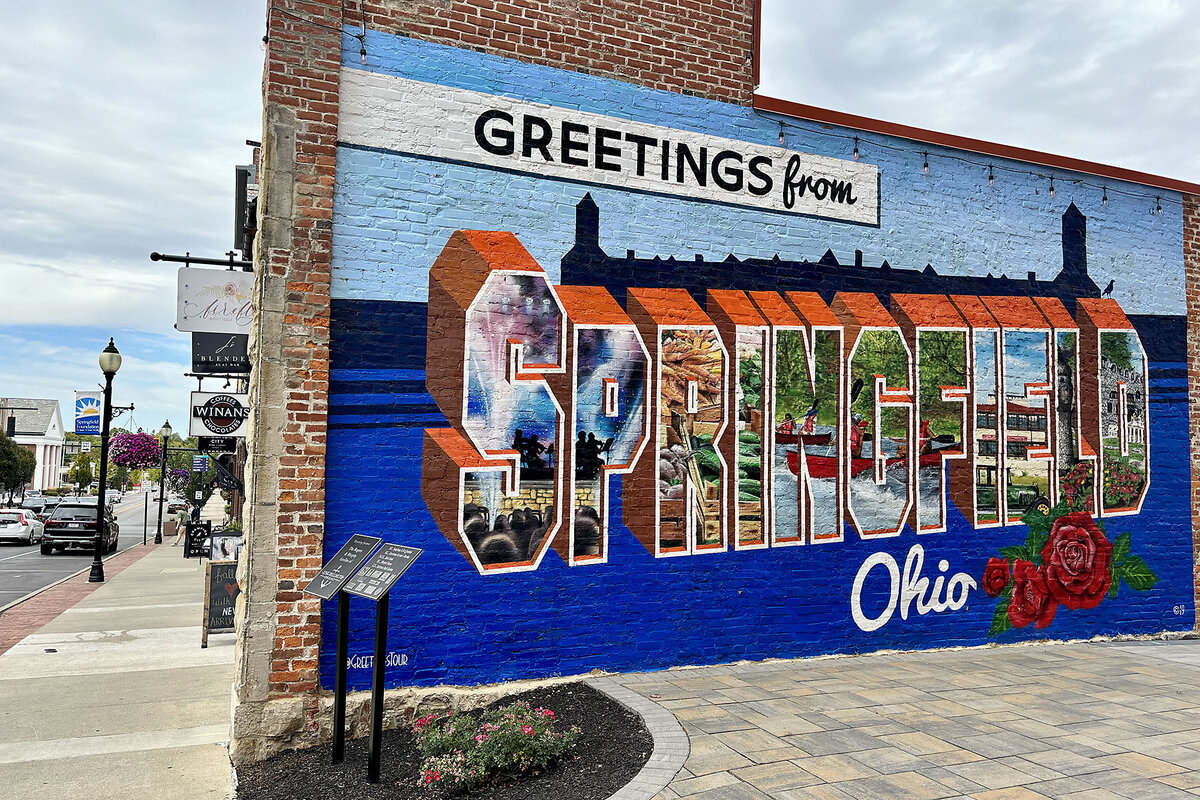
“This fight – it’s not just for us”
Back at Snowhill Elementary School, classes resumed Monday. Many students didn’t show up, Ms. Pankratz says, forcing teachers to shuffle lesson plans yet again. The chaos and fear have stymied learning, but one thing has not changed: Ms. Pankratz continues telling her students, including two Haitian children, that she loves them.
It’s a message she wants the city’s youngest members to grow up hearing.
The next generation includes Mr. Jerome’s baby daughter. The radio host says fatherhood has sharpened his resolve to help Springfield move forward.
“This fight – it’s not just for us,” he says. “It’s for the whole community and our kids.”
How is that being done? One human connection at a time.
On Wednesday morning, a laundry list of local officials and community partners convened virtually for a Clark County Haitian Coalition meeting. The chat box lit up with attendees trading contact information and offering help where needed.
Maybe they couldn’t meet in person on this day, but soon they could.

Today’s news briefs
• Haiti moves toward elections: Its government creates a provisional electoral council, marking the most concrete step toward reviving the electoral process in years. The Caribbean nation is set to hold elections by 2026, a decade after they were last held.
• Funding bill stalls in U.S. House: Republicans in the House of Representatives fail to pass a bill that included a controversial voting measure backed by Donald Trump, complicating efforts to avert a possible government shutdown at the end of the month.
• Hezbollah vows retaliation: The group’s leader, Hassan Nasrallah, vows to retaliate for this week’s deadly attacks on the group’s communication devices, in which at least 37 people were killed, including two children, and some 3,000 others were wounded. Israel and Hezbollah again exchanged strikes Sept. 19.
• No Teamsters endorsement: Despite a poll indicating that a majority of International Brotherhood of Teamsters members backed Republican candidate Donald Trump over Democrat Kamala Harris, the union is not making an endorsement in the presidential race, a first since 1996 for the 1.3 million-member union.

How Project 2025, designed to aid Trump, became a liability instead
It’s not uncommon for think tanks to publish ideas on how their preferred candidate could govern. Or to create lists of people a new administration could hire. Here’s how Project 2025, and the reaction to it, is different.

- Quick Read
- Deep Read ( 6 Min. )
The premise was simple. A Washington think tank sympathetic to Donald Trump would organize a policy blueprint and database of potential hires, helping the former president hit the ground running on his first day, should he win the presidency in November.
In a city full of policy shops eager for influence, the concept was hardly unusual.
But in the Trump era, nothing is simple. And instead of helping former President Trump, Project 2025 – the 922-page blueprint spearheaded by the conservative Heritage Foundation, with input from more than 100 partner organizations – has become a political lightning rod, and a gift to Vice President Kamala Harris.
From immigration and presidential power to climate and abortion, hot-button topics abound in Project 2025. Early attention focused on its controversial call to reinstate the Trump initiative known as Schedule F, which would turn tens of thousands of federal civil servants into political appointees, allowing them to be fired for reasons other than poor performance.
Yet the controversy, including Mr. Trump’s efforts to distance himself from the document, has only served to heighten its salience. With its detailed array of controversial recommendations laid out online, it has given Democrats seemingly endless fodder for attacks.
How Project 2025, designed to aid Trump, became a liability instead

The premise was simple. A Washington think tank sympathetic to Donald Trump would organize a policy blueprint and database of potential hires, helping the former president hit the ground running on his first day, should he win in November.
In a city full of policy shops eager to influence the agenda of future administrations, the concept was hardly unusual.
But in the Trump era, nothing is simple. And instead of helping former President Trump, Project 2025 – the 922-page blueprint spearheaded by the conservative Heritage Foundation, with input from more than 100 partner organizations – has become a political lightning rod, and a gift to Vice President Kamala Harris.
While many of the report’s more polarizing proposals come straight from the MAGA playbook, Project 2025 also raises thorny issues even within the populist right.
From immigration and presidential power to climate and abortion, hot-button topics abound in Project 2025. Early attention focused on its controversial call to reinstate the Trump initiative known as Schedule F, which would turn tens of thousands of federal civil servants into political appointees, allowing them to be fired for reasons other than poor performance.
Mr. Trump had instituted Schedule F late in his term as part of his effort to dismantle what he calls “the deep state” – the layers of employees in the government bureaucracy who he believed had slow-walked or even thwarted some of his policy goals. President Joe Biden quickly reversed the order upon taking office.
For months, Mr. Trump has been attempting to distance himself from the document.
“I have nothing to do with Project 2025,” the former president said when asked about it in his debate with Ms. Harris on Sept. 10. “I haven’t read it. I don’t want to read it, purposely. I’m not going to read it.”
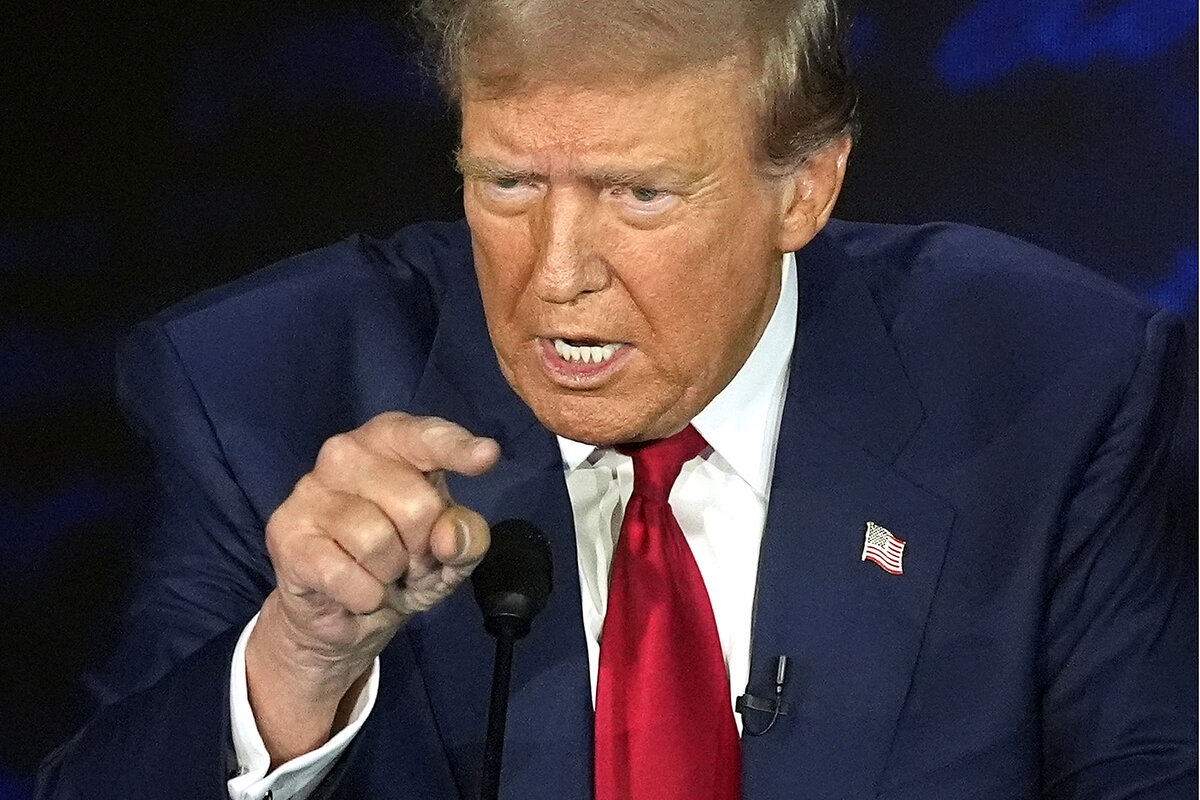
Yet the controversy has only served to heighten its salience, with Democrats now mentioning “Project 2025” every chance they get. And with its detailed array of controversial recommendations laid out online, it has given the Democrats seemingly endless fodder for attack ads and campaign speeches.
“Project 2025 has turned into a PR nightmare,” says a pro-Trump GOP strategist, who asked to speak without attribution in order to be candid.
Team Trump’s connections with Project 2025
Published in 2023, Project 2025 drew relatively little attention until this summer, when, over the July 4 weekend, Heritage Foundation President Kevin Roberts made a jaw-dropping statement. The nation, he said in a podcast, was “in the process of the second American Revolution, which will remain bloodless if the left allows it to be.”
The comment went viral, with its hint at violence that to critics brought back memories of the Jan. 6, 2021, attack on the U.S. Capitol by Trump supporters.
Days later, Mr. Trump posted that he knew “nothing about Project 2025.”
“I disagree with some of the things they’re saying and some of the things they’re saying are absolutely ridiculous and abysmal,” he wrote on his social media site.
Mr. Roberts has since taken over leadership of Project 2025, after the project’s previous director, Paul Dans, left Heritage in late July, reportedly under pressure from the Trump campaign.
When asked to comment on whether Heritage will continue to promote Project 2025 between now and Election Day, the think tank provided a statement from its president, Mr. Roberts, asserting that “conservatives are fully committed to focusing our efforts on helping defeat the left at the ballot box,” while not mentioning the document.
Yet for all Mr. Trump’s insistence that he knows nothing about Project 2025, political observers say he could well end up following some or even a lot of its policy recommendations. And its massive database of personnel recommendations could certainly prove useful in staffing a second term.
The web of connections between the project and people in Mr. Trump’s orbit is extensive. Dozens of officials and cabinet secretaries from his first term spearheaded or contributed to the Heritage report. Some – such as former budget director Russell Vought and former Homeland Security Deputy Secretary Ken Cuccinelli – could play key roles in a second Trump term.

Mr. Trump’s running mate, Ohio Sen. JD Vance, also wrote the foreword for a forthcoming book by Mr. Roberts, titled “Dawn’s Early Light: Taking Back Washington to Save America,” in which the vice presidential nominee calls for followers to “circle the wagons and load the muskets.” He describes Mr. Roberts’ ideas as an “essential weapon” in the “fights that lay ahead,” according to The New Republic, which downloaded a galley before it was removed from the NetGalley platform.
Heritage tome isn’t the only playbook for transition
Among its more controversial proposals, Project 2025 includes plans to cut Medicare and Medicaid, ban the pills used in medication abortions, relax regulations on greenhouse gas emissions, and abolish the Department of Education.
Lately, the report’s discussion of abortion – with almost 200 mentions – has been in the spotlight. While it does not call for a federal ban on abortion, it does assert vast, unilateral federal power to restrict access following the 2022 Supreme Court ruling that eliminated the nationwide right to the procedure.
Vice President Harris made protecting abortion rights a centerpiece of her convention speech last month, as she rattled off measures she claimed Mr. Trump would take in a second term – including an alleged plan to “create a national anti-abortion coordinator.”
Fact-checkers found many of Ms. Harris’ assertions on Mr. Trump and abortion either “mostly false” or not fact-checkable. Mr. Trump’s basic position on abortion is to “leave it up to the states.” But no matter. Ms. Harris accomplished her goal, framing the debate and uttering the words “Project 2025” ominously in her speech, which was viewed by 29 million people.
Other convention speakers in Chicago also drove the message home, carrying to the stage oversized versions of the Heritage Foundation book “Mandate for Leadership,” which lays out Project 2025.

“You ever see a document that could kill a small animal and democracy at the same time? Here it is,” joked Kenan Thompson of “Saturday Night Live.”
Some Trump allies argue that Project 2025 was mostly aimed at reasserting the relevance of the decades-old Heritage Foundation. The real planning for a second Trump term, they say, is being done by another think tank, the America First Policy Institute, which was set up by Mr. Trump’s team in 2021. The AFPI board is chaired by Linda McMahon, who ran the Small Business Administration (SBA) under Mr. Trump – and is now co-chair of the Trump transition.
Ms. McMahon is a rare figure in Mr. Trump’s orbit who wins praise from a wide spectrum in the Washington establishment.
“Linda McMahon has had real government experience in her time at SBA,” says Max Stier, CEO of the nonpartisan Partnership for Public Service and an expert on presidential transition planning. “My only experience working with her has been very positive.”
Meanwhile, Mr. Trump’s official plan for a second term, as outlined on his campaign website, is called Agenda47. The former president’s agenda is also laid out in somewhat greater depth in the new Republican platform, which was unveiled at the party convention in July. However, even that reads more like a series of talking points than a detailed policy blueprint.

Why Putin’s nuclear saber-rattling on Ukraine sounds different now
The Kremlin has had little success invoking its nuclear arsenal to deter Ukraine and the West from deploying new tactics and modern equipment to stop Russia’s invasion. But that may be changing.

- Quick Read
- Deep Read ( 4 Min. )
Over the course of the war in Ukraine, the Kremlin has drawn several “red lines,” only to seemingly do nothing when these lines are crossed by Ukraine or its Western backers.
But Russian President Vladimir Putin warned last Thursday that Moscow will consider it a direct act of war by NATO if British, French, or U.S.-made missiles are used by Ukraine to strike targets deep inside Russia. And both he and Russian experts say this time, things are different.
Mr. Putin distinguished the use of the weapon types being discussed – British, French, and American missiles – from previous red-line scenarios because he said such weapons would require hands-on NATO assistance and satellite targeting and guidance to effectively carry out strikes deep inside Russia.
The Kremlin sounds like it’s treating this challenge as the final straw.
“Russia’s frustration has been growing because the West appears to have lost all fear of nuclear war,” says Sergei Strokan, an international affairs columnist. “There is a growing feeling that the West needs some kind of a wake-up call, an event that would make them see they are flirting with World War III.”
Why Putin’s nuclear saber-rattling on Ukraine sounds different now
Over the course of the war in Ukraine, the Kremlin has drawn several “red lines” – with ostentatious references to Russia’s huge strategic nuclear arsenal – only to seemingly do nothing when these lines are crossed by Ukraine or its Western backers.
It happened when Ukraine acquired new and more powerful Western arms. It happened when Kyiv used its own drones to hit Russian airfields, refineries, and even the Kremlin itself. Most recently, it happened when Ukrainian forces actually invaded Russian territory. That has led Ukrainians, and many NATO officials, to conclude that Russian President Vladimir Putin’s nuclear saber-rattling is an elaborate bluff.
But when Mr. Putin warned last Thursday that Moscow will consider it a direct act of war by NATO if British, French, or U.S.-made missiles are used by Ukraine to strike targets deep inside Russia, he said this time is different.
Many Russian experts agree. And for now, Washington seems to be heeding his threat and holding off on permitting Ukraine to use the weapons.
“Russia’s frustration has been growing because the West appears to have lost all fear of nuclear war. Deterrence is absent,” says Sergei Strokan, an international affairs columnist with the Moscow daily Kommersant. During the Cold War, he says, that fear drove both sides to the bargaining table, aiming to limit conflicts and control nuclear weapons.
“There is a growing feeling that the West needs some kind of a wake-up call, an event that would make them see they are flirting with World War III if they escalate these attacks against Russia,” he says.
Deterrence and the war in Ukraine
Mr. Putin, responding to a question from a journalist, distinguished the use of the weapon types being discussed – British and French cruise missiles and U.S.-made ATACMS ballistic missiles – from previous red-line scenarios because he said such weapons are too sophisticated to be operated by Ukrainians alone. He claimed they would require hands-on NATO assistance and satellite targeting and guidance to effectively carry out strikes deep inside Russia.

“This will mean that NATO countries – the United States and European countries – are at war with Russia. And if this is the case, then, bearing in mind the change in the essence of the conflict, we will make appropriate decisions in response to the threats that will be posed to us,” Mr. Putin said.
The Kremlin sounds like it’s treating this challenge as the final straw. For over a year Mr. Putin has been under public pressure from hawkish members of his security elite, led by foreign policy dean Sergey Karaganov, to “restore deterrence” by staging a demonstration nuclear strike in order to remind the West that Russia is a nuclear superpower that shouldn’t be trifled with.
It’s not clear what response the Kremlin may be mulling, but the Russian media are a hotbed of speculation about it.
At the mild end of the spectrum are steps such as cutting off diplomatic relations, especially with the NATO country that Moscow views as the most actively hostile one, the United Kingdom. Another idea would be to stage a demonstration nuclear weapons test, something Russia has not done since 1990. Some reports say the old Soviet Arctic nuclear testing site at Novaya Zemlya has already been prepared for that possibility.
Sergei Markov, a former Kremlin adviser, says a stronger response might be to attack NATO airfields in Poland and Romania where, he says, “We know Ukrainian F-16s are based. These aircraft would probably be used in launching those NATO missiles at us, so we would regard them as legitimate targets.”
Forthcoming changes to Russia’s official nuclear doctrine may radically change the calculus for unleashing nuclear weapons.
At present, Russia would be prepared to use atomic weapons only in the case that the country is attacked with them by a nuclear-armed power, or if the very existence of the Russian state is threatened amid a conventional conflict.

Mr. Markov says the amendments under consideration would lower the threshold for employing tactical nuclear weapons, perhaps making them an integral part of any future battlefield.
Another revision might change the provision that Russian statehood must be in peril to instead enable the weapons to be used when Russian “strategic interests” are threatened. It would also allow their use against non-nuclear states that are part of a coalition that includes nuclear-armed powers if they are attacking Russia.
Fear of nuclear war
According to Alexei Levinson, an expert with the Levada Center, Russia’s only independent polling agency, fear of nuclear conflict has been growing among the Russian population since the Ukraine war began, from around a quarter of respondents to over a third.
“In our focus groups, we find it is the second biggest fear after concern for the well-being of self and immediate family,” he says. “It has escalated since the beginning of the special operation and is at a constantly high level.”
One of Russia’s top security experts, Alexei Arbatov, told the daily Nezavisimaya Gazeta this week that the drift of events is very dangerous because of the widespread belief in the West that Russia would never use nuclear arms.
“This is a very serious misconception: at some point, nuclear weapons will be used, despite the risk of escalation and general catastrophe,” he said.
Mr. Strokan argues that Western observers do not appreciate the extent to which Mr. Putin is under pressure from hawks to his right, such as the nuclear strike advocate Mr. Karaganov.
“Putin is probably the most moderate politician in Moscow right now, and if it weren’t for him we’d probably get a collective Karaganov in power,” he says. “Even now they are expressing open impatience and asking, ‘Why haven’t we pressed the button already?’”

Patterns
European governments, under pressure, raise barriers to migrants
“We can do this,” former German Chancellor Angela Merkel said of her welcome to over a million Syrian refugees in 2015. Today, Europe’s message to migrants is, “We won’t do this.”

- Quick Read
- Deep Read ( 4 Min. )
Just a few months ago, the 27 members of the European Union thought they had a balanced deal on immigration that would last.
It involved strengthening the bloc’s external borders, and funding governments on the other side of the Mediterranean Sea to keep a lid on refugee crossings. But the EU would still accept significant numbers of migrants, sharing the financial burdens and resettlement among member states.
But right-wing nationalist parties have made electoral gains recently, and that has prompted even centrist and center-left governments in Germany, France, and Britain, among others, to toughen their treatment of foreign migrants.
Even if European leaders can withstand political pressure from the far right, they will still have to strengthen their weak and inadequate procedures for receiving, lodging, investigating, and processing asylum-seekers.
And they face an even longer-term challenge. It is all but certain that the number of people seeking refuge – or merely a better life – in Europe will continue to grow in the years ahead, as they flee oppression and war, poverty and, increasingly, the ravages of climate change.
And simple demographics suggest that Europe has a growing economic need for new arrivals.
But for the time being, that is not an argument that many European leaders dare make.
European governments, under pressure, raise barriers to migrants

Country by country, Europe is toughening its treatment of foreign migrants. And while the politics behind the shift are crystal clear, the implications for the Continent’s cohesion, cooperation, and future growth are looking much murkier.
The political impetus comes from recent electoral gains by right-wing nationalist parties such as Marine Le Pen’s National Rally in France, the Reform UK party in Britain, and the Alternative für Deutschland (AfD) in Germany.
Quite apart from concerns about what the hardened approach will mean for asylum-seekers’ human rights, the new measures could strain the unity of the 27-nation European Union.
And there’s an ironic twist: As Europe’s population ages, many countries need immigrant workers to provide the tax base to pay for government services and sustain growth.
With tens of thousands of asylum-seekers every year jeopardizing their livelihoods, even risking their lives, to reach Europe, far-right parties have been stoking fears of a repeat of the much larger influx that followed former German Chancellor Angela Merkel’s 2015 welcome to hundreds of thousands fleeing the war in Syria.
Until recently, the EU felt confident it had come up with an agreed-upon joint strategy.
It involved strengthening the bloc’s external borders, and funding governments on the other side of the Mediterranean Sea to keep a lid on refugee crossings, while still accepting significant numbers of migrants and sharing the financial burdens and resettlement among member states.
Now, however, there is a stark shift toward individual national action.

And the most recent moves are not by right-wing governments. They’re from the center-left leaders of Europe’s three main economic powers: France, Britain, and Germany.
French President Emmanuel Macron has backed tougher residency and employment rules for immigrants, and weaker appeal provisions for asylum-seekers, broadly in line with Ms. Le Pen’s policy platform.
In Britain, new Prime Minister Keir Starmer headed to Rome this week, declaring himself eager to learn from the experience of Italy’s right-wing Prime Minister Giorgia Meloni in reducing the number of asylum-seekers.
Ms. Meloni has relied on deals with the authoritarian leaders of Tunisia and Libya, underwritten by hundreds of millions of dollars in EU aid, to crack down on Mediterranean crossings.
Mr. Starmer also showed interest in the deal she has done with Albania, to build a processing facility where migrants seeking asylum in Italy will be detained until their status is decided.
That approach could prove controversial within Mr. Starmer’s own Labour Party. One of his first acts as prime minister was to shelve a plan by the previous Conservative government to fly asylum-applicants from Britain to Rwanda – a scheme blocked by Britain’s Supreme Court.
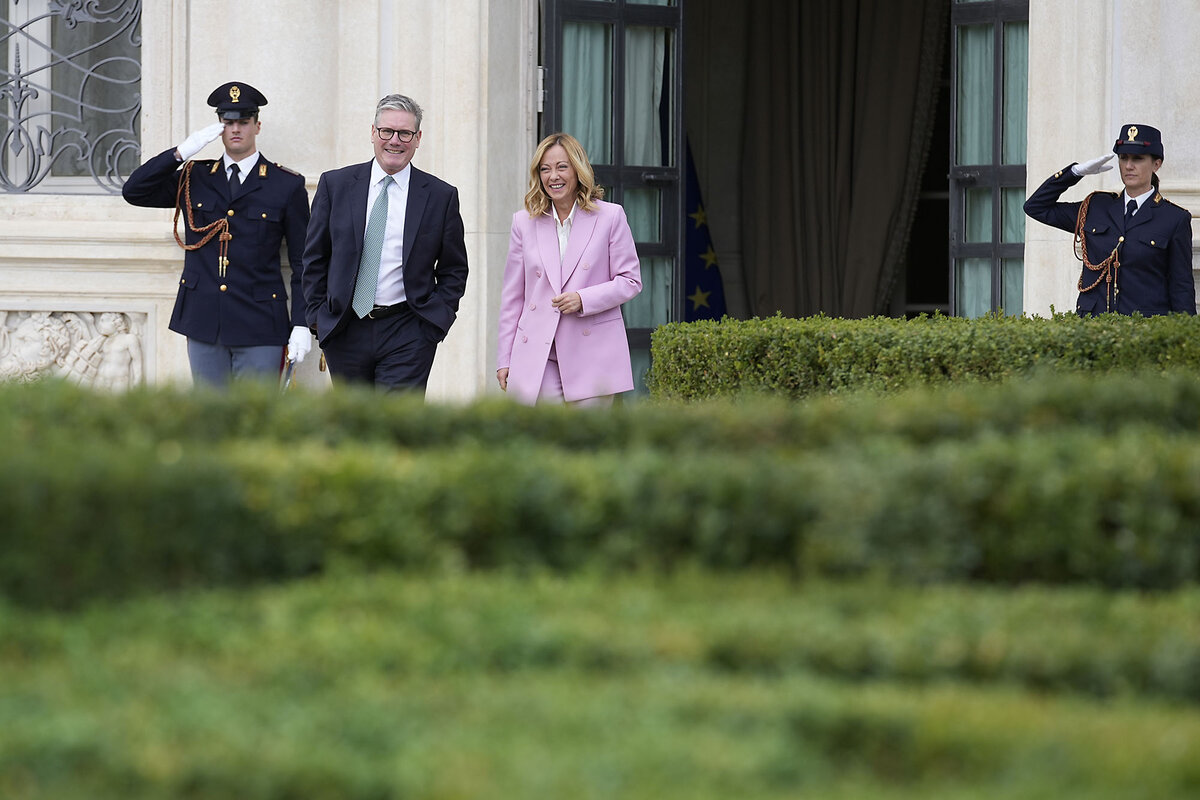
Still, it is the German government that has taken the most striking, and potentially impactful, step.
Against the background of AfD successes in two state elections, and the prospect of victory in a third state poll next week, Chancellor Olaf Scholz reintroduced checks at all Germany’s land-border crossings, with the declared aim of turning back any asylum-seeker who had already sought refuge in another EU country.
These frontier controls fly in the face of one of the European Union’s proudest achievements – borderless travel across the entire bloc, from Poland to Portugal.
And with other EU states voicing their concern, it remains to be seen whether Mr. Scholz will keep the border checks in place beyond their initial six-month term.
But the more daunting challenge for European leaders may be to find a way to move beyond the immediate far-right political pressures and agree to sustainable, longer-term policies on immigration and asylum.
The latest figures actually show an overall fall in the numbers of asylum-applicants reaching European shores this year.
Still, EU leaders have long recognized there are real, practical problems they must address, such as inadequate external border security and overtaxed facilities to receive, lodge, investigate, and process the often destitute and desperate new arrivals.
In many countries, the authorities have also failed to integrate migrants into local society. That has proved a dangerous weakness when incidents such as the recent stabbing spree by a young Syrian asylum-seeker in Germany prompted widespread reactions against immigrants generally.
Governments face a longer-range policy challenge as well.
Despite Italy-style deals to crack down on sea crossings, it is all but certain that the number of people seeking refuge – or merely a better life – in Europe will continue to grow in the years ahead, as they flee oppression and war, poverty and, increasingly, the ravages of climate change.
And simple demographics suggest that Europe has a growing economic need for new arrivals.
Still, most European leaders have shied away from making that case as they debate immigration policies.
When Chancellor Merkel took the lead in accepting Syrian refugees in 2015, she said she was acting from more than just a moral imperative. She knew that EU countries were wealthy enough to afford to welcome them.
“Wir schaffen das,” she said. “We can do this.”
Europe’s message today is not that “we can’t do this.”
It’s that, for now at least, they won’t do this.

Books
Kick off your fall with the Monitor’s 10 best books of September
Fall brings a return to the routines of work and school. Making time in your schedule for the 10 best books of September gives you the riches of the season.

-
By Staff
Kick off your fall with the Monitor’s 10 best books of September
The Life Impossible, by Matt Haig
Matt Haig’s tender second novel after “The Midnight Library” revisits the question of how to live your best life. When a retired, widowed math teacher in England inherits property on a Spanish island from a former colleague who has disappeared under mysterious circumstances, she can’t resist the unsolved problem.
Tell Me Everything, by Elizabeth Strout
Elizabeth Strout’s warmhearted novel brings together her best-loved characters, including Olive Kitteridge, Bob Burgess, and Lucy Barton, in the fictional town of Crosby, Maine. “Tell Me Everything” is about how stories about others’ lives – and how really listening – help us understand and connect.
Colored Television, by Danzy Senna
Jane has one year to finally finish her second novel, but can she balance professional ambition with marriage, motherhood, and her yearning for stability? Danzy Senna takes a searing look at personal authenticity, the struggles of a creative life, and the powerful impact of racial identity.
Playground, by Richard Powers
Richard Powers intertwines the stories of school buddies Todd and Rafi, troubled geniuses both; trailblazing diver and scientist Evie; and South Pacific-born artist Ina. Whether considering the excitement of discovery, community sovereignty and control, or free thought and artificial intelligence, the novel offers a boatload to ponder. It’s a plea for play – and responsibility.
The Fallen Fruit, by Shawntelle Madison
Since the late 1700s, the Bridge farm in Virginia has offered a haven for its freeborn Black owners. But there’s a caveat: A child born to each Bridge man will fall back in time. As the novel opens, Cecily, a mother in 1964, begins investigating her ancestors’ time-traveling troubles. It’s an engaging take on freedom and free will.
Katharine, the Wright Sister, by Tracey Enerson Wood
Tracey Enerson Wood’s historical novel pays joyful tribute to the sister of Wilbur and Orville Wright, the unsung heroine behind their discovery of flight in 1903. She helped mastermind the Wright family’s rise from humble beginnings to worldwide fame and fortune.
Paris in Ruins, by Sebastian Smee
Impressionism emerged in late-1860s Paris. But the movement took off only after the horrors of the Franco-Prussian War drove artists to create works focused on the impermanence of life. This deeply researched and well-written book combines art and biography with political and military history to shed fresh light on the origins of this seminal period in modern art.
Reagan: His Life and Legend, by Max Boot
Forty years after Ronald Reagan’s last run for the White House, journalist and foreign policy analyst Max Boot constructs the most extensive biography to date of the 40th U.S. president. Boot points to Reagan as a public figure who was famously difficult to know, though the author does his best to capture the 20th century’s most dominant conservative by talking with Reagan’s associates.
America First, by H.W. Brands
H.W. Brands delivers a stirring account of the tumultuous period before the United States entered World War II. The prolific historian focuses on the rivalry between President Franklin D. Roosevelt, who supported intervention, and celebrated aviator Charles Lindbergh, an isolationist ardently opposed to American involvement.
Keeping the Faith, Brenda Wineapple
Historian Brenda Wineapple delves into what is known as the Scopes Monkey Trial. The 1925 court case wrangled with not only the theory of evolution, but also access to ideas, respect for religion, and the tensions between science and theology in ways that are remarkably familiar today.
Other headline stories we’re watching
(Get live updates throughout the day.)The Monitor's View
Humble pivots to a political center
- Quick Read
- Deep Read ( 3 Min. )
-
By the Monitor's Editorial Board
More than two months after French voters left Parliament without a ruling party, their country has a mounting debt crisis and no one in charge to solve it. It has fallen to Michel Barnier, a moderate conservative newly appointed as prime minister, to cobble France’s headbutting political factions into a governing coalition.
In a year when more than 60 nations are holding elections, Mr. Barnier can draw fresh lessons from other places where voters have forced political rivals to share power. One insight that has emerged from ballots already held is that the most effective governing partnerships may be those that bridge the widest divides.
Take South Africa, for instance. In May, voters ended three decades of one-party rule under the African National Congress (ANC). The party faced a decision: Team up with smaller factions that might have drawn it further leftward, or turn to a rival with whom it shared a history of ideological differences. Choosing the latter has paid dividends.
Shared governance fosters a willingness of rivals to see the good in each other; its moderating effect ripples outward.
Humble pivots to a political center

More than two months after French voters left Parliament without a ruling party, their country has a mounting debt crisis and no one in charge to solve it. It has fallen to Michel Barnier, a moderate conservative newly appointed as prime minister, to cobble France’s headbutting political factions into a governing coalition.
In a year when more than 60 nations are holding elections, Mr. Barnier can draw fresh lessons from other places where voters have forced political rivals to share power. One insight that has emerged from ballots already held is that the most effective governing partnerships may be those that bridge the widest divides.
Take South Africa, for instance. In May, voters ended three decades of one-party rule under the African National Congress (ANC). The party faced a decision: Team up with smaller factions that might have drawn it further leftward, or turn to a rival with whom it shared a history of ideological differences.
Choosing the latter has paid dividends. “The mood is better, the scope for doing things is better, the capital markets are favourable,” Andrew Donaldson, a former National Treasury official, told The Brenthurst Foundation last week. An assessment by the International Monetary Fund this month noted signs of new economic stability and resilience.
Debate over a new education bill illustrates what that optimism rests on. The ANC and its main coalition partner, the Democratic Alliance, are deeply divided over a provision in the bill that would allow the national government to override regional decisions about what language schools use for instruction. South Africa has 11 official languages. Minority groups worry about retaining cultural autonomy.
The debate remains unresolved, but it has not broken a shared commitment to civility and accommodation between the rivals-turned-partners. President Cyril Ramaphosa, of the ANC, told Parliament last week, “I don’t work on the basis that we are going to differ to a point of even parting ways. I have often worked on the basis ... that for every problem there is a solution.”
Mr. Ramaphosa has delayed implementing the legislation to try to soften the impasse. That gained his governing partner’s appreciation. “It is of critical importance to understand that conflict over policy in a multi-party government ... is normal and indeed necessary in a democracy,” Democratic Alliance leader John Steenhuisen told business leaders in Cape Town last week.
Shared governance fosters a willingness of rivals to see the good in each other; its moderating effect ripples outward. In India, for example, observers credit a new period of coalition government brought on by elections this spring for softening the hard-line Hindu nationalist policies of Prime Minister Narendra Modi.
In France, as The Atlantic once noted, the expression en même temps (often translated as “on the other hand”) suggests “either a willingness to listen and reflect, or an unwillingness to choose.” As he builds a coalition to govern, Prime Minister Barnier may follow the wisdom of the former. “Every citizen is necessary,” he insisted recently. He may already be listening to the lessons of civility and respect now emerging from South Africa and elsewhere.

A Christian Science Perspective
Each weekday, the Monitor includes one clearly labeled religious article offering spiritual insight on contemporary issues, including the news. The publication – in its various forms – is produced for anyone who cares about the progress of the human endeavor around the world and seeks news reported with compassion, intelligence, and an essentially constructive lens. For many, that caring has religious roots. For many, it does not. The Monitor has always embraced both audiences. The Monitor is owned by a church – The First Church of Christ, Scientist, in Boston – whose founder was concerned with both the state of the world and the quality of available news.
Let Christ establish your day
- Quick Read
- Read or Listen ( 3 Min. )
-
By Warren Berckmann
As we’re receptive to God’s thoughts, our day conforms more fully to their messages of love.
Let Christ establish your day
The apostle Paul, urging his listeners to challenge and overcome materialistic thinking through spiritual “warfare,” enjoins us to bring “into captivity every thought to the obedience of Christ” (II Corinthians 10:5). He doesn’t say some thoughts, but every thought.
What does this mean? Why is being obedient to this guidance important, and how do we do so?
If we pay attention to what we’re thinking throughout the day, we find myriad thoughts coming to us. Some of these thoughts are good and helpful. Others are laden with fear, frustration, or anger. We can ask ourselves, “What is the origin of those thoughts?”
Just as Paul distinguishes between “the carnal mind” (Romans 8:7), which he condemns, and “the mind of Christ” (I Corinthians 2:16), which he understood to be supreme – “the power of God, and the wisdom of God” (I Corinthians 1:24) – so Christian Science teaches that the divine Mind, the Mind Christ Jesus expressed, is the real and only Mind, and that man, including everyone, is God’s spiritual reflection. It teaches that the carnal mind or mortal mind is a mistaken concept of God and man – the very opposite of the Mind that is God.
Since God is good, thoughts that are good are real, coming from God. Thoughts unlike good are unreal, invalid – and therefore powerless to affect us, provided we are alert to them and guard our consciousness against their entry.
This process of watching our thought to determine what we let in is not a mere human technique. It is the activity of God’s love and our response to that love. This gets to the very heart of what Christ is – the true idea of God coming to human consciousness, evidencing God’s deep love for us.
Jesus in his parables and Paul in his treatises taught that it matters what we are accepting into our mental home. Paul describes spiritual warfare against “the works of the flesh” (including idolatry, hatred, strife, and envy). Then he lists contrasting, Godlike, qualities such as love, joy, gentleness, and so forth, stating, “against such there is no law” (Galatians 5:19-23). To me, this shows that engaging in spiritual warfare is a matter of invoking divine law.
In his Sermon on the Mount, Jesus explains how to pay attention to and discipline our thoughts. These teachings and Jesus’ accompanying healing works make clear that real causation is in God. To the degree that we bring our consciousness into conformity with the Mind that Christ Jesus claimed as his own, we repudiate mortal thoughts and beliefs and their outward effects, and thereby experience harmonious and healthful being.
Haven’t most of us found ourselves at one time or another carried along with the general drift of mortal thinking – believing ourselves to be at the mercy of material “laws” of health, accepting “natural” disasters as inevitable, taking offense at what others do or don’t do? Mary Baker Eddy, the discoverer of Christian Science, instructs us how to diligently guard the door of our consciousness to allow only thoughts that originate in God to enter.
Calvin Hill, a member of Mrs. Eddy’s household, recalls her saying to him, in substance, “The first thing I do in the morning when I awake is to declare I shall have no other mind before divine Mind, and become fully conscious of this, and adhere to it throughout the entire day; then the evil cannot touch me” (“We Knew Mary Baker Eddy”: Expanded Edition, Vol. 1, p. 353).
As we do this consistently each morning and throughout the day, we establish our day (God’s day) in consciousness before getting drawn into mortal mind’s thoughts, beliefs, and depiction of events. This is not the activity of two contending powers. Rather, it’s the omnipotence of divine Love demonstrating the powerlessness, the unreality, of evil and the omnipresence, the reality, of good.
Even if we awaken in the morning with negative thoughts and fears, which are certainly not from God, we can practice Mrs. Eddy’s own spiritual discipline as described above. We can effectively reject those counterfeit, ungodlike thoughts, and admit the counter facts from God in obedience to Christ.
To the degree that we uplift the Christ in our consciousness, we will express to others the Christly love that includes all humanity in its embrace, and they, too, will be drawn to Christ – to the healing consciousness of supreme good.
Adapted from an editorial published in the Nov. 27, 2023, issue of the Christian Science Sentinel.

Viewfinder
At the water’s edge

A look ahead
Thanks for diving into your Daily today. Tomorrow we’ll have another deep read: a report from Taylor Luck and Erika Page from Tunisia, where three global crises – political instability, inequality, and climate change – now converge. What does the effect of that mean for migration, in Tunisia and elsewhere?



